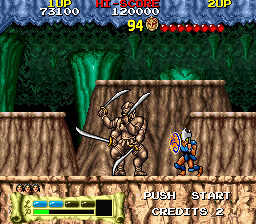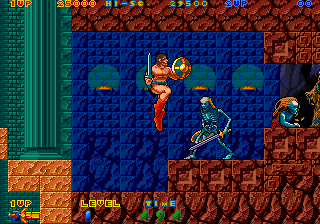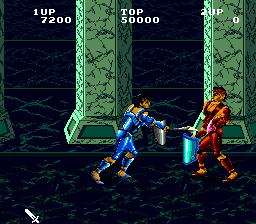Mattel's Intellivision games had a distinctive art and trade dress credited to artist Jerrol Richardson. The games' covers would feature a main scene of action with one or two circular insets depicting other scenes. It's often been noted but games from around that period often had more vivid art and packaging to offset the limited graphics of the period.
Sunday, July 31, 2022
Saturday, July 23, 2022
Joust (1982)
Jousting by itself is as good a concept as any for a video game. In 1982 John Newcomer added flight to it when he designed Joust for Williams.
With the flying bird concept settled, he decided to go with a two-way joystick - similar to Defender's but horizontal instead of vertical - and a single button to control flapping. The faster you hit the button, the faster you ascend, so the core of the game is mastering the sense of the characters' weight. It's also an early example of a two-player cooperative game, with player 2's character riding the back of a stork to make for a visually distinct sprite.
The game is essentially a deathmatch scenario. The player controls a golden knight riding his ostrich. He has to defeat every other enemy on the screen. The bad guys all ride buzzards and come in three flavors: Bounders (red) are fairly stupid; Hunters (gray) are more aggressive and will even attempt to hover over the player in some circumstances; and Shadow Lords (blue) are very fast and powerful and tend to zoom into the air and bounce off the "ceiling" downward just as fast, making them very dangerous. Defeating an enemy simply requires that the player's lance makes contact with them on a higher plane (being perfectly level with an enemy results in a draw of course). When an enemy is beaten, his bird drops an egg and the player must scoop it up before it hatches. If it hatches, it reveals an enemy of the next level higher level, but the player still has a few seconds to run him over before he mounts a fresh buzzard.
The field is peppered with floating platforms, so the characters all have to try to kill each other while quickly slipping through the gaps in the platforms. As the game progresses, platforms will vanish - open space tends to favor the computer since the player is outnumbered and can't hide as much above or beneath the platforms. There's also a lava pit surrounding the lowest level and early on a "lava troll" will start trying to grab fliers who drop too low over the pit. The troll doesn't discriminate and will grab enemies, too. If grabbed, the player needs to hammer the flap button rapidly to ascend out of the troll's grip while hoping an opportunistic enemy doesn't kill them while they're immobilized (and the player can benefit from this in the opposite circumstance).
To prevent rounds from dragging, before long an ear-splitting cry will announce the coming of the "Unbeatable?" Pterodactyl, an invincible creature that homes in on the player until the round is finished. The reason for the question mark, though, is that a last-minute programming change resulted in the pterodactyl being vulnerable in a tiny spot, allowing the player to temporarily vanquish it through a pixel-perfect strike into its mouth.
Joust is as perfect an arcade game as has ever been created, especially if one is grading based on how a game feels to play. Unlike Defender, which was deliberately designed to frighten players with the complexity of its controls (you have to push a button just to switch direction), Joust's controls are approachable. The physics are extremely finely tuned and easy to get to grips with in terms of gravity and the rhythm of hitting the flap button, as well as understanding the bird's sense of speed. When the game is really up to speed, the sense of soaring through the air is unparalleled in a game of its time. You actually feel graceful while playing it. As a contrast, Nintendo released a Joust clone called Balloon Fight a couple of years later, and while it's a very good game, it's still inferior to Joust in terms of how it feels to play.
Joust has a fair difficulty curve. It looks and sounds great, too. Williams's games tended to have instantly memorable soundscapes, and the animation by Bill Pfutzenreuter is smooth and conveys a sense of character, particularly touches like the how the ostrich will do a Looney Tunes-style foot-braking when it has to stop after running.
Tuesday, July 19, 2022
The Astyanax (1989)
Despite the title, Astyanax isn't about the son of Hector of Troy. The player controls a hero who must, as ever, hike across the land and battle monsters until he defeats a dark lord. The game, distributed by Jaleco and known in Japan as The Lord of King, was designed by Rastan's Toshiyuki Nishimura and Tokuhiro Takemori, with Takemori listed as director.
For a core game mechanic, Takemori brought a concept around which he'd based one of his previous games, The Legendary Axe, namely that the hero's axe has a power meter that charges up between attacks. The idea being that you have a choice between attacking a lot at low power, or saving up to unleash a much stronger blow. As it is, Astyanax is such a frantic game that most players will probably just hack away as fast as possible at the litany of foes coming from all sides. The player also can make limited use of a screen-clearing magical attack. Among the bosses are another instance of a multi-armed statue likely influenced by the Kali statue in The Golden Voyage of Sinbad, and a two-headed dragon.
Unlike some other games, Astyanax does follow a relatively consistent path in settings. The attract mode displays a huge tower rising on an island in the middle of a lake that is connected to the surrounding land by a long, narrow bridge. Indeed, the player starts out in a forested area, then moves through cave, then onto the bridge, then penetrating the castle/tower to meet the evil wizard. Because it was the 80s, the final level has the hero bust into a Giger-esque biomechanical hellhole and face skittering monsters that rear up to display mouths that look like vagina dentata, culminating in a battle against a final boss that attacks with an arm that extends across the screen, presumably because having its mouth shoot outward would have been a bit too much for the lawyers. With the job done, the tower and its island crumble and sink and the world is made safe again.
It's not a bad game, but it does overall feel inferior to the console games it's related to, both Legendary Axe for the PC Engine and the NES console port of Astyanax, which keeps the axe-charging mechanic and hack-and-slash gameplay but otherwise reworks the game quite a bit. The graphics in this arcade game are reasonably good, but it feels a bit rote in its side-scrolling design and it's so hyperactive that it renders the charge attack almost pointless.
Tuesday, July 12, 2022
Rastan Saga II/Nastar (1988)
Wednesday, July 6, 2022
Tuesday, July 5, 2022
Gladiator (1986)
Gladiator was created by Allumer and distributed by Taito in 1986, Japanese title Ougon no Shiro (Golden Castle). Despite the Western title, you're not controlling a gladiator in the arena fighting sense, but rather an armored swordsman as he ascends the floors of a tower, attempting to gain access to the riches of the treasure room at the pinnacle.
The gameplay itself takes two forms. In the first, the hero, apparently named Great Guaranos (or Gurianos), walks from left to right down a lengthy hallway, blocking hails of projectiles - fireballs, blades, arrows, etc. - with his sword and shield. Having survived this onslaught, the hero is met by a series of warriors who try to prevent him from mounting the stairs to the next level. There are four levels before the game loops and becomes even more difficult, and it is already very difficult at the start. Among the opponents are other men with varying weapon choices, a swordswoman, a fire-breathing demon, a bow-shooting amazon, and eventually an undead skeleton.
The game's most distinguishing feature is that the fighters are all armored and their armor needs to be broken piece by piece before a killing blow can be struck in the exposed flesh. Both sword and shield can be held high, low, or in the middle, (joystick controls shield, three buttons control the sword attacks) so battles involve the opponents going for openings in the guard while simultaneously moving the shield up or down to stave off a strike. However, the shield itself can be worn down to little more than a strip of metal if too many blocks are made. On the player's side, many of the enemies' swords can be broken if hit enough, for those who want to try a more conservative style.
The game might not look like much today, but at the time of its release its exceptionally large, well-defined and muscular characters were quite striking and the gameplay was frantic yet encouraged strategy in how offense and defense should be managed. There are also some fun wrinkles, such as the ability to create a forcefield if the magical shield is picked up, the ability to turn invincible if certain conditions are met, or the ability to scoop up one enemy's mace as a replacement weapon.
SKALD: Against the Black Priory (2024)
SKALD: Against the Black Priory is a Kickstarted RPG by Anders Laurindsen that hearkens back to classic PC RPGs, particularly those for t...

-
Dishonored, released by Arkane Studios, probably isn't most people's idea of a traditional sword-and-sorcery work. The player cont...
-
Art by Brom Heretic is the fourth game released by Raven Software, a studio founded by Brian and Steve Raffel. With their debut game, an A...
-
Cover by Simon Bisley, best known as a comics artist but he's done a few game covers. He's never made a secret of Frazetta's inf...







-01.png)



